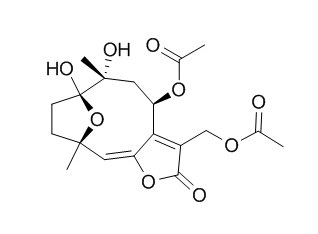Diacetylpiptocarphol
Diacetylpiptocarphol shows antileishmanial activity against three stages of Leishmania infantum.
Inquire / Order:
manager@chemfaces.com
Technical Inquiries:
service@chemfaces.com
Tel:
+86-27-84237783
Fax:
+86-27-84254680
Address:
1 Building, No. 83, CheCheng Rd., Wuhan Economic and Technological Development Zone, Wuhan, Hubei 430056, PRC
Providing storage is as stated on the product vial and the vial is kept tightly sealed, the product can be stored for up to
24 months(2-8C).
Wherever possible, you should prepare and use solutions on the same day. However, if you need to make up stock solutions in advance, we recommend that you store the solution as aliquots in tightly sealed vials at -20C. Generally, these will be useable for up to two weeks. Before use, and prior to opening the vial we recommend that you allow your product to equilibrate to room temperature for at least 1 hour.
Need more advice on solubility, usage and handling? Please email to: service@chemfaces.com
The packaging of the product may have turned upside down during transportation, resulting in the natural compounds adhering to the neck or cap of the vial. take the vial out of its packaging and gently shake to let the compounds fall to the bottom of the vial. for liquid products, centrifuge at 200-500 RPM to gather the liquid at the bottom of the vial. try to avoid loss or contamination during handling.
Plant Pathology2022, 10.1111:ppa.13651.
Plants (Basel).2023, 12(6):1259.
J AOAC Int.2024, qsae028.
Front Chem.2022, 10:1048467.
J Appl Microbiol.2022, 132(2):949-963.
Nutrients.2019, 11(11):E2694
Nutrients.2022, 14(23):4997.
Appl. Sci.2020, 10(8),2804
Agronomy2020, 10(10),1489
Biomed Pharmacother.2024, 174:116598.
Related and Featured Products
J Ethnopharmacol. 2015 Jul 21;170:167-74.
Evaluation of antiplasmodial and antileishmanial activities of herbal medicine Pseudelephantopus spiralis (Less.) Cronquist and isolated hirsutinolide-type sesquiterpenoids.[Pubmed:
25980423]
METHODS AND RESULTS:
Aerial parts of P. spiralis were extracted with either ethanol or distilled water. Seven hirsutinolide-type sesquiterpenoids were isolated: 8-acetyl-13-ethoxypiptocarphol (1), Diacetylpiptocarphol (2), piptocarphins A (3), F (4) and D (5), (1S(*),4R(*),8S(*),10R(*))-1,4-epoxy-13-ethoxy-1,8,10-trihydroxygermacra-5E,7(11)-dien-6,12-olide (6), and piptocarphol (7). Extracts and isolated compounds (2, 3, 5-7) were screened for their in vitro antiplasmodial activity against the chloroquine-resistant Plasmodium falciparum strain FcM29-Cameroon and antileishmanial activity against three stages of Leishmania infantum. Their cytotoxicities were also evaluated against healthy VERO cell lines and J774A.1 macrophages, the host cells of the Leishmania parasites in humans.
CONCLUSIONS:
Aqueous extract and compounds Diacetylpiptocarphol, 3 and 6 were also active against L. infantum but lacked in selectivity due to their cytotoxicity towards macrophages.
Phytochemistry. 2010 Sep;71(13):1539-44.
Sesquiterpene lactones from Vernonia scorpioides and their in vitro cytotoxicity.[Pubmed:
20599237]
Fresh leaves of Vernonia scorpioides are widely used in Brazil to treat a variety of skin disorders. Previous in vivo studies with extracts of this species had also demonstrated a high antitumor potential.
METHODS AND RESULTS:
This paper reports isolation of four sesquiterpene lactones (hirsutinolides and glaucolides), together with Diacetylpiptocarphol, 8-acetyl-13-etoxypiptocarphol, luteolin, apigenin, and ethyl caffeate from fresh leaves and flowers of Vernonia scorpioides. The hypothesis that hirsutinolide 3 is formed during extraction was verified theoretically using Density Functional Theory. The effects of isolated compounds on in vitro tumor cells were investigated, as well as their genotoxicity by means of an in vitro comet assay.
CONCLUSIONS:
The results indicate that glaucolide 2 and hirsutinolide 4 are toxic to HeLa cells. These compounds were genotoxic in vitro, a property that appears to be related to the presence of their epoxy groups, which has been a more reliable indication of toxicity than substitution on C-13 or the presence of alpha,beta-unsaturated keto-groups.
These results need to be replicated in vivo in order to ascertain their toxicity.



